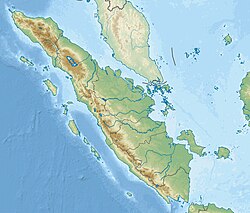| Musi River Sungai Musi, Air Musi, Musi River, Palembang River, Sungai Palembang, Air Moesi, Kali Musi | |
|---|---|
 Ampera Bridge over the Musi River | |
| Location | |
| Country | South Sumatra, Indonesia |
| Physical characteristics | |
| Source | |
| • location | Barisan Mountains, Kepahiang, Bengkulu |
| • coordinates | 3°24′21.528″S102°35′53.1204″E / 3.40598000°S 102.598089000°E |
| • elevation | 1,300 m (4,300 ft) |
| Mouth | |
• location | Bangka Strait, South China Sea, South Sumatra |
• coordinates | 2°19′51.7224″S104°55′19.9668″E / 2.331034000°S 104.922213000°E |
• elevation | 0 m (0 ft) |
| Length | 759 km (472 mi) [1] |
| Basin size | 56,931 km2 (21,981 sq mi) [2] 59,942 km2 (23,144 sq mi) [3] |
| Width | |
| • minimum | 250 m (820 ft) (Palembang) [4] |
| • average | 540 m (1,770 ft) (Palembang) [4] |
| • maximum | 1,350 m (4,430 ft) (Palembang) [4] |
| Depth | |
| • average | 8 m (26 ft)(Palembang) [5] |
| Discharge | |
| • location | Musi Delta, Bangka Strait |
| • average | (Period: 1992–2016)3,054 m3/s (107,900 cu ft/s) [2] (Period: 2016–2020)3,066 m3/s (108,300 cu ft/s) [6] (Period: 1971–2000)3,211.2 m3/s (113,400 cu ft/s) [1] (Period: 2009–2013)3,961Contentsm3/s (139,900 cu ft/s) [7] |
| Discharge | |
| • location | Palembang, (Confluence of Komering, 78 km upstream of mouth; Basin size: 53,500 km2 (20,700 sq mi) |
| • average | (Period: 1971–2000)2,953.7 m3/s (104,310 cu ft/s) [1] 2,700 m3/s (95,000 cu ft/s) |
| • minimum | 1,400 m3/s (49,000 cu ft/s) [3] |
| • maximum | 4,200 m3/s (150,000 cu ft/s) [3] |
| Discharge | |
| • location | Sekayu (Basin size: 21,146.3 km2 (8,164.6 sq mi)) |
| • average | (Period: 1971–2000)1,205.4 m3/s (42,570 cu ft/s) [1] |
| Discharge | |
| • location | Tebing Tinggi (Basin size: 3,329.7 km2 (1,285.6 sq mi) |
| • average | (Period: 1971–2000)183.6 m3/s (6,480 cu ft/s) [1] |
| Basin features | |
| Progression | South China Sea |
| River system | Musi River |
| Tributaries | |
| • left | Kungku, Klingi, Lakitan, Rawas, Harileko, Sebalik |
| • right | Keru, Nibung, Lintang, Kikim, Semangus, Keruh, Langgaran, Medak, Simpang, Dua, Penukal, Lematang, Belida, Kramasan, Ogan, Komering |
The Musi River (Indonesian : Sungai Musi) is a river in Southern Sumatra, Indonesia. [8] It flows from south-west to north-east, from the Barisan Mountains range that form the backbone of Sumatra, in Kepahiang Regency, Bengkulu Province, to the Bangka Strait that forms an extension of the South China Sea. The Musi is about 750 kilometers long, and drains most of South Sumatra province. After flowing through Palembang, the provincial capital, it joins with several other rivers, including the Banyuasin River, to form a delta near the town of Sungsang. The river, dredged to a depth of about 8 meters, [5] is navigable by large ships as far as Palembang, which is the site of major port facilities used primarily for the export of petroleum, rubber and palm oil.
This river system, especially around the city of Palembang, was the heart of eponymous 7th to 13th century Srivijayan empire. The river mouth was the site of the SilkAir Flight 185 plane crash which killed all 104 passengers and crew on board in 1997. [9]





